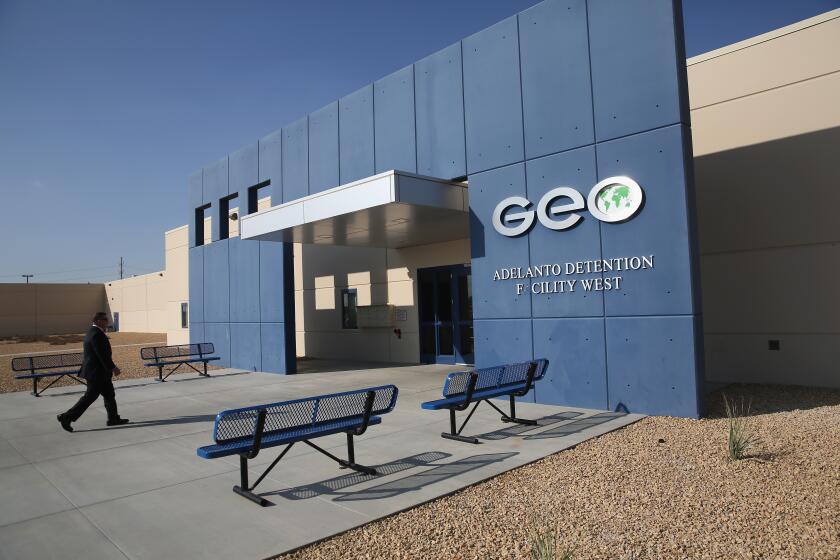Trump promised vast deportations to Mexico. Why are the numbers so low?

- Share via
- U.S. federal data show deportations of all nationalities — not just Mexicans — are lagging behind Biden-era levels.
- At this rate, the Trump administration is unlikely to meet its stated goal of 1 million deportations annually.
- Mexico has agreed to accept non-Mexicans who have been deported from the United States.
MEXICO CITY — Since President Trump took office in January vowing the “largest deportation operation in American history,” Héctor Silva has been bracing for an influx of deportees at the two migrant shelters he runs in the Mexican border city of Reynosa.
It hasn’t arrived. Silva’s shelters, which can house up to 5,000 people, have been nearly empty for months.
“The truth is we haven’t received the massive wave of deportees that they warned about,” he said. “I expected something very different.”
Under Trump, the U.S. is deporting fewer people to Mexico than it was at this time last year, new data show.
Mexican President Claudia Sheinbaum said this week that since Trump took office Jan. 20, the U.S. has deported 33,311 Mexicans.
That is considerably fewer than in 2024, when the Biden administration deported 52,253 Mexicans between February and April.

U.S. federal data show deportations of all nationalities — not just Mexicans — are lagging behind Biden-era levels, and that at this rate, the Trump administration is unlikely to meet its goal of one million deportations annually.
There are several explanation for the decline in deportations.
Illegal border crossings have dropped to their lowest point this century, thanks to a Mexican campaign to interdict northbound migrants and Trump’s actions to end asylum at the U.S. border.
Many of the deportees counted under Biden were migrants apprehended at the border and turned back quickly. The Trump administration, however, has been focused on deporting migrants already inside the U.S., where locating, detaining and removing them is more complicated and more expensive than it is at the border.
To speed up removals, the White House has asked lawmakers for tens of billions of dollars in new funding to hire more federal agents and vastly expand immigrant detention. “The more money we got, the more bad guys we take off the street, the safer America is,” Tom Homan, Trump’s “border czar,” said he told members of Congress earlier this year.
In Mexico, meanwhile, the threatened uptick in deportees has not materialized.
“There haven’t been many,” Sheinbaum said recently, noting that Mexico was considering reducing the size of the emergency tent shelters it erected along its northern border to provide food, medicine and psychological support in anticipation of a large number of returning migrants.
Meanwhile, Sheinbaum has acknowledged that her nation is also accepting U.S. deportees who are not Mexicans — 5,446 since Trump’s second term began.
For months, the White House has been pushing countries around the world to take migrants who come from countries that don’t always accept deportation flights from the U.S.
Panama and Costa Rica are two countries that have agreed to temporarily take deportees from as far away as Iran, Afghanistan and China, on the stipulation that they will eventually be resettled elsewhere.
At her daily news conference Tuesday, Sheinbaum said Mexico has not signed a formal agreement with the U.S. to take any so-called “third-party” migrants. The deportees it has so far accepted were welcomed for “humanitarian” reasons, she said. She did not name their nationalities, and said most deportees sent to Mexico would return home “voluntarily.”
But the Mexican government’s handling of the migrants has been opaque, and it’s clear that there are some migrants recently deported from the U.S. to Mexico who are languishing here.
Though Sheinbaum’s remarks this week focused on numbers, immigrant rights activists — and the migrants themselves — note that each number reflects a very human tale, often one of desperation.
Osmany Ramírez is a Cuban migrant who lived in Houston since 2021, working legally as an Uber driver while he waited for his asylum case to be heard. He said he was detained by federal authorities in an immigration raid outside a grocery store on Good Friday, a few days before Easter.
Shortly thereafter, he was released into Reynosa, Mexico, along with a Haitian man and a Nicaraguan family. Ramírez, 55, said they were then driven by Mexican authorities more than 700 miles south, and eventually released at a migrant shelter in the city of Villahermosa, in Tabasco state.
Ramírez says he is afraid to either return to Cuba or cross back to the United States, where his wife lives. He says he plans to apply for asylum in Mexico, which, if granted, would give him permission to work.
But for now, he has nothing. He said Mexican officials said he would be detained if he tried to reach the nation’s capital.
“They left us here with no belongings, without anything at all,” Ramírez said.
Migrant advocates say the legal status of third country migrants sent from the U.S. to Mexico is unclear, and leaves them vulnerable.
“They are absolutely in the shadows once they get to Mexico,” said Adam Isacson, who studies the border at the Washington Office on Latin America, a human rights nonprofit.
Arturo Rocha, a former senior migration official in the Mexican government, said major questions remain about how, exactly, Mexico is collaborating with U.S. immigration officials and how it will care for migrants returned here.
“If you’re accepting migrants for humanitarian reasons, then you should give them documents to help them integrate into Mexican society and the formal labor market, and not leave them going from shelter to shelter and struggling with their families,” he said.
Migrant advocates say that all deportees — Mexicans and international — are being shuttled by the National Guard to points south, including in Tabasco and Chiapas, which are near Guatemala.
It seems to be a plan based on optics, they said.
“I believe the Mexican government’s strategy is to prevent large numbers of people from being seen at the border, because that would reflect poorly on the Trump administration,” said Esther Gutiérrez, who runs Casa Nazareth shelter in Nuevo Laredo.
Special correspondent Cecilia Sánchez Vidal in Mexico City contributed this report.
More to Read
Sign up for Essential California
The most important California stories and recommendations in your inbox every morning.
You may occasionally receive promotional content from the Los Angeles Times.











